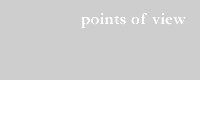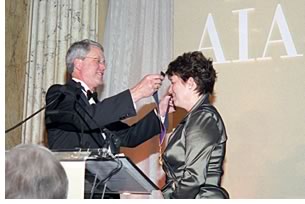

1/2006
Listening Before the Leap


 by Kate Schwennsen,
FAIA
by Kate Schwennsen,
FAIA
Who started the custom of inaugurating the new AIA president in December? Whoever it was, thank you!
Yes, there is always the risk of bad weather. With so many attendees flying into Washington from around the country—and beyond—you can be sure I had one eye on the Board agenda and the other on the weather report. Still, cold fronts and low-pressure systems notwithstanding, I wouldn’t trade the risk of a whiteout for the three weeks of relative calm between the inauguration and the work that starts up immediately after the New Year. It’s a precious opportunity to recall what I have been hearing this past year from AIA members and to let those words shape my actions in the new year.
As most AIA members know, nearly a year and a half elapses between the election of a president at the AIA National Convention and the actual passing of the torch. Those months turn out to be an essential apprenticeship, during which the president-to-be chairs the strategic planning process, memorizes Robert’s Rules of Order (or at least knows who has the book), and learns how to pace herself during long meetings with infrequent breaks.
Listening like never before
But of far greater importance is the opportunity to get outside the bubble
of one’s self to listen; listen like never before to what architects
are saying about practice, education, the shape of the profession,
the AIA, and the world our profession serves. This is important because
the role of president, as I see it, is not to advance one’s own
agenda but to advance the agenda of our members. Not everything, mind
you. Rather, to listen carefully to discover as best as one can the
important distinctions that separate immediate wants from longer-term
needs.
What I have heard since being elected is that we are not complacent about our present prosperity but are in fact eager to strike out boldly toward a preferred destination for our profession. There is, I believe, broad consensus that getting to this destination will require us to change the “how,” the “who,” and the “what” of architectural practice.
- The “how” needs to become both more personal and more digitized
- The “who” needs to become more inclusive
- The “what” needs to become more innovative, knowledge-based, and sustainable.
The educator in me is very interested in the future of our profession. What do we hope for the generation of architects who will be planning our bicentennial? How do we want them to be valued by society? What do we hope they are creating and contributing?
Access to every ounce of energy
The woman in me is, not surprisingly, interested that the “who” of
our profession become more inclusive, more diverse. Why? On a pragmatic
level, it comes down to this: If our community of architects does not
have access to a complete and inclusive labor pool, we cannot possibly
know enough or be innovative enough to compete. Without access to every
ounce of the rich cultural, genetic, creative, and spiritual energy that
is a unique blessing and essential resource of our multicultural society,
we will severely limit our potential.
The achievement of a diverse and inclusive profession that mirrors the society we serve will not only improve our marketing and technical edge, it will also inevitably lead us to be stronger advocates for the public good and stronger advocates for making the world more commodious, sustainable, and delightful.
Our future success is also closely tied to our stewardship of this planet, which leads me home to my Iowa roots.
Although current agricultural practices are far from sustainable, the heritage of Iowa as I know it, learned it, and live it is the ethical imperative to leave the place better than you found it. This value, along with equally ingrained values including making do with little, working hard for the simple reward of hard work, being progressive and pragmatic, and speaking plainly and directly, are of the Iowa soil. These values sustain me and will root all my actions as AIA president.
A year of transition
2006 will be a year of transition for the AIA. It will be a year of transition
in the executive vice president’s office, from one exemplary
leader to another. It will be a year of transition to and preparation
for our 150th anniversary. And it will be another year of transition
from a 20th century, industrial age profession to a 21st century, digital
age profession, in which anyone who assumes a leadership position,
in fact anyone who is a member, should think of the AIA as something
special, something important, something of great value that has been
delivered into our care.
In this quiet time before the work of the new year begins, I will be thinking back on what I have heard from AIA members; I will be thinking about how together we can best sustain the AIA, nurture it, and steer it to a higher, more influential place, a place of ever increasing service to society. With your help, I will aim high in hope and work, and I will nurture this organization and profession as if it were my own, which, of course, it is.
Copyright 2006 The American Institute of Architects.
All rights reserved. Home Page ![]()
![]()
Outgoing AIA President Douglas L Steidl, FAIA, presents incoming President Kate Schwennsen with the President’s Medal.
![]()